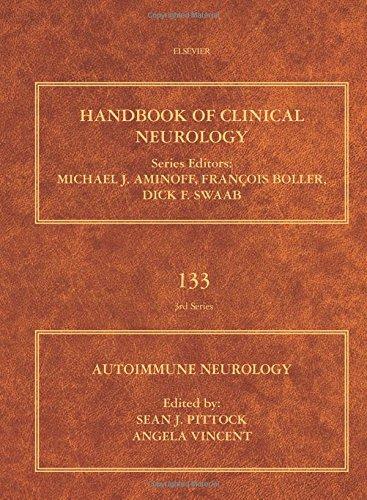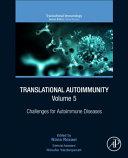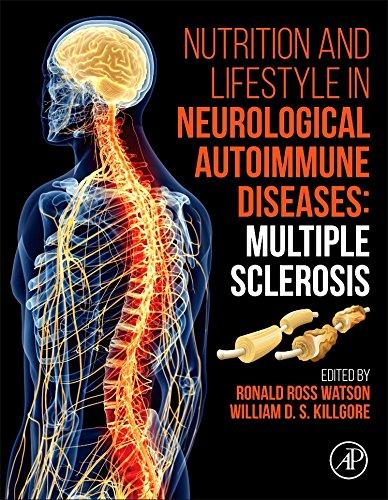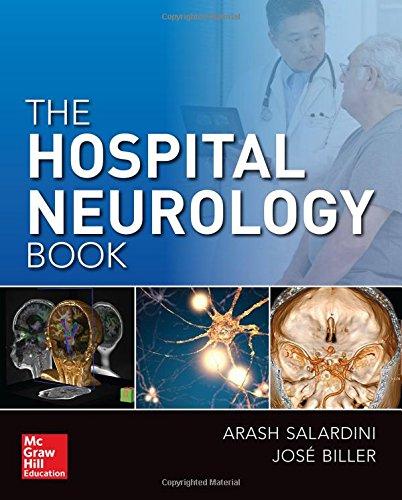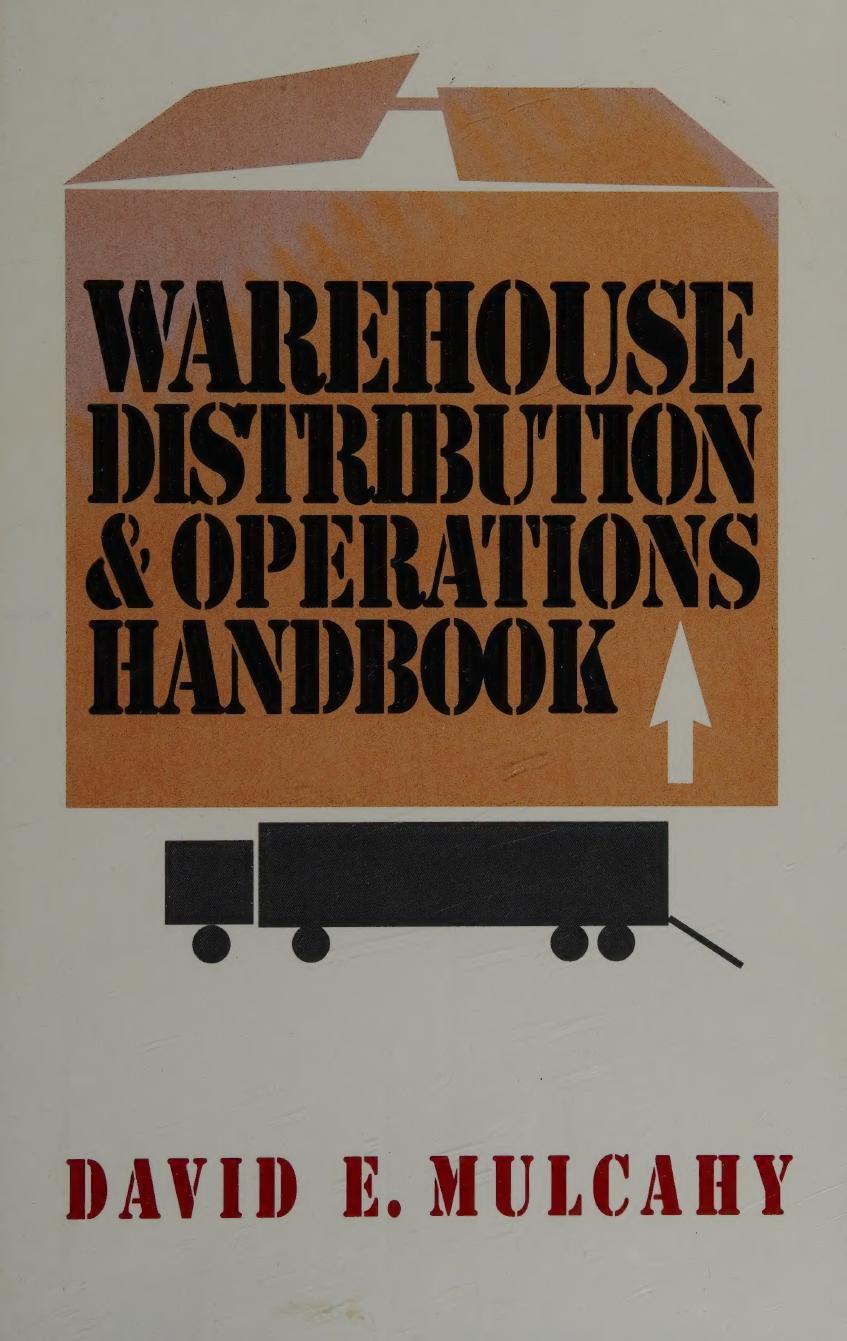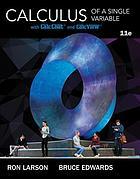https://ebookmass.com/product/autoimmune-neurology-1st-
Instant digital products (PDF, ePub, MOBI) ready for you
Download now and discover formats that fit your needs...
Translational Autoimmunity. Volume 5: Challenges for Autoimmune Diseases Nima Rezaei
https://ebookmass.com/product/translational-autoimmunityvolume-5-challenges-for-autoimmune-diseases-nima-rezaei/
ebookmass.com
Nutrition and Lifestyle in Neurological Autoimmune Diseases: Multiple Sclerosis 1st Edition Ronald Ross Watson
https://ebookmass.com/product/nutrition-and-lifestyle-in-neurologicalautoimmune-diseases-multiple-sclerosis-1st-edition-ronald-ross-watson/
ebookmass.com
The Hospital Neurology Book 1st Edition Arash Salardini
https://ebookmass.com/product/the-hospital-neurology-book-1st-editionarash-salardini/
ebookmass.com
Emerging technologies for sustainable desalination handbook Veera Gnaneswar
Gude (Editor)
https://ebookmass.com/product/emerging-technologies-for-sustainabledesalination-handbook-veera-gnaneswar-gude-editor/
ebookmass.com
Freedom's Crescent: The Civil War and the Destruction of Slavery in the Lower Mississippi Valley John C. Rodrigue
https://ebookmass.com/product/freedoms-crescent-the-civil-war-and-thedestruction-of-slavery-in-the-lower-mississippi-valley-john-crodrigue/
ebookmass.com
No Accident Steven F. Havill
https://ebookmass.com/product/no-accident-steven-f-havill-2/
ebookmass.com
A History of Modern Africa 3rd Edition Richard J. Reid
https://ebookmass.com/product/a-history-of-modern-africa-3rd-editionrichard-j-reid/
ebookmass.com
Warehouse distribution and operations handbook David E Mulcahy
https://ebookmass.com/product/warehouse-distribution-and-operationshandbook-david-e-mulcahy/
ebookmass.com
Calculus of single variable : with CalcChat and Calcview 11e Edition Edwards
https://ebookmass.com/product/calculus-of-single-variable-withcalcchat-and-calcview-11e-edition-edwards/
ebookmass.com
ELSEVIER
Radarweg29,POBox211,1000AEAmsterdam,Netherlands TheBoulevard,LangfordLane,Kidlington,OxfordOX51GB,UK 50HampshireStreet,5thFloor,Cambridge,MA02139,USA
Copyright © 2016ElsevierB.V.Allrightsreserved.
Nopartofthispublicationmaybereproducedortransmittedinanyformorbyanymeans,electronicormechanical, includingphotocopying,recording,oranyinformationstorageandretrievalsystem,withoutpermissioninwriting fromthepublisher.Detailsonhowtoseekpermission,furtherinformationaboutthePublisher’spermissions policiesandourarrangementswithorganizationssuchastheCopyrightClearanceCenterandtheCopyright LicensingAgency,canbefoundatourwebsite: www.elsevier.com/permissions.
ThisbookandtheindividualcontributionscontainedinitareprotectedundercopyrightbythePublisher(otherthan as may benotedherein).
Notices
Knowledgeandbestpracticeinthisfieldareconstantlychanging.Asnewresearchandexperience broadenourunderstanding,changesinresearchmethods,professionalpractices,ormedicaltreatmentmay becomenecessary.
Practitionersandresearchersmustalwaysrelyontheirownexperienceandknowledgeinevaluatingandusingany information,methods,compounds,orexperimentsdescribedherein.Inusingsuchinformationormethodsthey shouldbemindfuloftheirownsafetyandthesafetyofothers,includingpartiesforwhomtheyhaveaprofessional responsibility.
Withrespecttoanydrugorpharmaceuticalproductsidentified,readersareadvisedtocheckthemostcurrent informationprovided(i)onproceduresfeaturedor(ii)bythemanufacturerofeachproducttobeadministered,to verifytherecommendeddoseorformula,themethodanddurationofadministration,andcontraindications.Itis theresponsibilityofpractitioners,relyingontheirownexperienceandknowledgeoftheirpatients,tomake diagnoses,todeterminedosagesandthebesttreatmentforeachindividualpatient,andtotakeallappropriatesafety precautions.
Tothefullestextentofthelaw,neitherthePublishernortheauthors,contributors,oreditors,assumeanyliability foranyinjuryand/ordamagetopersonsorpropertyasamatterofproductsliability,negligenceorotherwise,or fromanyuseoroperationofanymethods,products,instructions,orideascontainedinthematerialherein.
BritishLibraryCataloguing-in-PublicationData
AcataloguerecordforthisbookisavailablefromtheBritishLibrary
LibraryofCongressCataloging-in-PublicationData
AcatalogrecordforthisbookisavailablefromtheLibraryofCongress
ISBN:978-0-444-63432-0
ForinformationonallElsevierpublications visitourwebsiteat https://www.elsevier.com/
Publisher: ShirleyDecker-lucke
AcquisitionEditor: MaraConner
EditorialProjectManager: KristiAnderson
ProductionProjectManager: SujathaThirugnanaSambandam
Designer: AlanStudholme
TypesetbySPiGlobal,India
Foreword
Weareproudtopresentforthefirsttimeavolumeofthe HandbookofClinicalNeurology devotedtoautoimmune neurologicdisorders.Theconceptofantibody-associatedencephalitiswasfirstintroducedin1966byLordBrain.The neurologicconsequencesofantibodiestoacetylcholinereceptorshavebeenstudiedforsometimebut,inrecentyears, anumberofnovelantibody-associatedautoimmuneneurologicdisordershavebeendefined.Theantibodiesagainst neuralantigens,someparaneoplastic,areoftenspecifictorelativelywell-definedsyndromesandcanbeidentifiedin serumorcerebrospinalfluid.
Theclinicalfeaturesofautoimmunedisordersofthenervoussystemincludeprominentneurologicandpsychiatric disturbances.Thesedisorders,whichconstitutearapidlyemergingsubspecialty,arereflectedinthecontentsofthe presentvolume,whichcomprises27chapters,dividedintothreeparts.Followingtheintroductoryfirstpart,thesecond dealswiththebasicprinciplesofneurobiologyandimmunology,fromthesignalingmoleculesofthecentralnervous systemthatarethetargetsofautoimmunitytoanimalmodelsofautoimmuneneurologicdisorders.Thethirdpart dealswiththeclinical,diagnostic,andtherapeuticaspectsofautoimmuneneurologicandneuropsychiatric disorders.Therecentdiscoveryofnovelantibodiesagainsttargetsontheneuronalsurfacethatareoftenpresent inpatientswithpreviouslyunexplainedneuropsychiatricdeficitsisespeciallyinteresting,sincesuchpatientscan besuccessfullytreatedimmunologically.
Weareveryfortunatetohaveasvolumeeditorstwodistinguishedscholars,SeanJ.PittockfromtheMayoClinic, Rochester,USA,andAngelaVincent,fromtheJohnRadcliffeHospital,UniversityofOxford,UK.Theyhaveassembledanexcellentinternationalandmultidisciplinarygroupofexpertswhomtheyhavecarefullyguidedincreatingthis comprehensivebook.Wearegratefultothemandtoallthecontributors.
Thisvolumewillbeofinterestnotonlytoclinicalneurologistsandpsychiatrists,butalsotoimmunologists andbasicneuroscientists.Aprintversionisavailablebutinterestisincreasingintheelectronicversionofthe Handbook series,availableonElsevier’sScienceDirectwebsite,whichfacilitatesitsaccessibility.
Asalways,itisapleasuretothankElsevier,ourpublisher – andinparticularMichaelParkinsoninScotlandand KristiAndersonandMaraE.ConnerinSanDiego – fortheirexcellentassistancewiththedevelopmentandproduction ofthisvolume.
MichaelJ.Aminoff Franc ¸ oisBoller DickF.Swaab
Preface
Autoimmuneneurologyisoneofthemostexcitingandrapidlyevolvingfieldsincontemporaryneurology,andrepresentsanewsubspecialtydrivenmainlybydiscoveryofnovelneural(neuronalorglial)-specificautoantibodiesand theirtargetantigens.Autoimmunedisordersmayaffecteverylevelofthenervoussystem,fromcortex(epilepsy, encephalopathy,dementia)toneuromuscularjunctionandmuscle(myastheniagravis,autoimmunemyositis),and areincreasinglyrecognizedasimportantandtreatablecausesofneurologicdisease.Autoimmuneneurologytranscends traditionalbordersofneurologicsubspecialtiesandisrelevanttobehavioralneurology,epilepsy,neuro-infectious disease,neuro-oncology,andneuromuscular(peripheralnerve,muscle,autonomic)andmovementdisorders.
Thefieldisonlybeginningtofinditsfootingasanindependentsubspecialty.Internationalandnationalneurologic societiesnowfrequentlyoffereducationalcoursesandsymposiathatprovideupdatesandoverviewsofwhatmany consideracomplexandconfusingconstellationofconditions.Thiscomplexityishighlightedinthegrowingnumbers ofpublicationsrelatingtonoveldiagnosticbiomarkers,theirtargets,mechanismsofaction,andcancerandviral associations,andnewtherapeuticoptions.Aseditorswithapassionateinterestinthisarea,whohaveworkedcollaborativelyinthepast,werecognizedthatacomprehensivetextbookonautoimmuneneurologywasabsentfromcurrent literatureandweconsideredtheinternationalformatofthe Handbook seriesanidealfoundationforafirsttextbookin thisarea.
Ourgoalwastoprovideaneasy-to-readbutcomprehensiveoverviewofthistranslationalsubspecialty.Todothis webroughttogetherinternationallyrecognizedexpertsfromEuropeandNorthAmericaandaskedthemtoprovidea clearandconciseoverviewinaclinicallyrelevantcontext.Weencouragedthemtoincludealittlehistoryandbackground,buttomainlyfocusonrecentpublications.Thistheyhavedoneveryeffectivelybutthereaderneeds toappreciatethatthisyoungfieldlacksstandardizedguidelinesfordiagnosisandtreatment,andspecificapproaches todiagnosisandtreatmentmaydifferfromexperttoexpertandfrominstitutiontoinstitution.Thereis,therefore, apressingneedformulticenterstudiesondiagnosticalgorithmsandtherapeuticmanagementstrategies.
Thetextbookisdividedintothreeparts.Thefirstpartprovidesabriefbutwideintroductiontothefield.Thesecond partincludesbasicscienceoverviewsofsynapticsignalingmolecules,theblood–brainbarrier,immunology,cellular andmolecularoutcomesofatargetedimmuneattack,neuronalandglialimmunopathology,andanimalmodels.We hopethatthesechapterswillprovideasolidgroundingtoallowreaderstobegintoaskpertinenttranslationalresearch questionsastheymoveintotheclinicalpart.Thisthirdsection,writtenbyclinicianswithexpertiseindiagnosisand treatmentofautoimmuneneurologicdisorders,isorganizedaccordingtothenervoussystemlevelinvolved,starting atthecerebralcortexanddescendingtomuscle.Thefinalchaptersummarizescurrentapproachestoimmunotherapies andsomefutureprospects.
Itremainsasignificantchallengeandtimecommitmenttowriteabookchapter.Wesincerelythankourcontributorsfortheirhelpinmakingthisbookareality.Aseditorswehavetriedtocreateaflowofconceptsandideasfrom starttofinishandverymuchappreciateourcontributors’flexibilitywithrespecttochanges,additions,anddeletions thatwererequiredtominimizeoverlap,avoidduplication,andmaximizecohesionacrossthehandbook.
WewouldliketoacknowledgethemanycontributionsofIvanRoitt,IanSimpson,VandaLennon,JonLindstrom, DanDrachman,KlausToyka,AndrewEngel,RicardoMiledi,JohnGriffinandJohnNewsom-Davisandtheir colleagues,whoplayedessentialrolesindemonstratingtheimportanceofautoantibodiesintheperipheralnervous system.Overthelast15yearsthefieldhasgrownandwidenedconsiderablyandthatwouldnothavebeenpossible withoutthemajorcontributionsofVandaLennonandJosepDalmau.Weverymuchappreciatethetechnicalexpertise andhelpintransatlanticcoordinationofchaptersandproofreviewsprovidedbyMaryCurtis,andhelpandsupport providedbyDominicaLuscombe.Finally,wethankourfamiliesfortheirsupportandpatienceinallowingusto prepareandcompletethisvolume. SeanJ.PittockandAngelaVincent
Contributors
R.Balice-Gordon
DepartmentofNeuroscience,PerelmanSchoolof MedicineattheUniversityofPennsylvania, Philadelphia,PAandNeuroscienceandPainResearch Unit,Pfizer,Inc.,Cambridge,MA,USA
J.Bauer
CenterforBrainResearch,MedicalUniversityVienna, Vienna,Austria
E.E.Benarroch
DepartmentofNeurology,MayoClinic,Rochester, MN,USA
S.M.Benseler
DivisionofRheumatology,DepartmentofPaediatrics, AlbertaChildren’sHospital,AlbertaChildren’sHospital ResearchInstitute,CummingSchoolofMedicine, UniversityofCalgary,Alberta,Canada
C.G.Bien
Epilepsy-CentreBethel,KrankenhausMara,Bielefeld, Germany
B.F.Boeve
DepartmentofNeurology,MayoClinic,Rochester, MN,USA
M.Bradl
DepartmentofNeuroimmunology,CenterforBrain Research,MedicalUniversityVienna,Vienna,Austria
J.Britton
DepartmentofNeurology,MayoClinic,Rochester, MN,USA
E.Coutinho
NuffieldDepartmentofClinicalNeurosciences,John RadcliffeHospital,Oxford,UK
M.A.A.M.deBruijn
DepartmentofNeurology,ErasmusUniversityMedical Center,Rotterdam,TheNetherlands
D.A.Drubach
DepartmentofNeurology,MayoClinic,Rochester, MN,USA
E.P.Flanagan
DepartmentofNeurology,MayoClinic,Rochester, MN,USA
M.Gorman
DepartmentofNeurology,BostonChildren’sHospital andHarvardMedicalSchool,Boston,MA,USA
S.R.Hinson
DepartmentsofLaboratoryMedicine/Pathologyand Neurology,MayoClinic,CollegeofMedicine, Rochester,MN,USA
M.Y.Hu
DepartmentofNeurology,YaleSchoolofMedicine, NewHaven,CT,USA
S.R.Irani
NuffieldDepartmentofClinicalNeurosciences,John RadcliffeHospital,Oxford,UK
A.Jain
DepartmentofNeuroscience,PerelmanSchoolof MedicineattheUniversityofPennsylvania, Philadelphia,PA,USA
C.J.Klein
DepartmentofNeurology,MayoClinic,Rochester, MN,USA
B.Lang
NeuroimmunologyGroup,NuffieldDepartmentof ClinicalNeurosciences,JohnRadcliffeHospital, Oxford,UK
H.Lassmann
DepartmentofNeuroimmunology,CenterforBrain Research,MedicalUniversityVienna,Vienna,Austria
V.A.Lennon
DepartmentsofLaboratoryMedicine/Pathologyand Neurology,MayoClinic,CollegeofMedicine, Rochester,MN,USA
M.Lim
Children’sNeurosciences,EvelinaLondonChildren’s HospitalatGuy’sandSt.Thomas’NHSTrust, KingsHealthPartnersAcademicHealthScience Centre,LondonandNuffieldDepartmentof ClinicalNeurosciences,JohnRadcliffeHospital, Oxford,UK
C.F.Lucchinetti
DepartmentofNeurology,MayoClinic,Rochester, MN,USA
A.Mammen
NationalInstituteofArthritisandMusculoskeletal andSkinDisorders,NationalInstitutesofHealth, Bethesda,MDandDepartmentofNeurology, JohnsHopkinsUniversitySchoolofMedicine, Baltimore,MD,USA
A.McKeon
DepartmentsofNeurologyandLaboratoryMedicine andPathology,MayoClinic,Rochester,MN,USA
K.L.Medina
DepartmentofImmunologyandDepartmentof Medicine,MayoClinic,Rochester,MN,USA
R.J.Nowak
DepartmentofNeurology,YaleSchoolofMedicine, NewHaven,CT,USA
B.Obermeier
Neuro/ImmunoDiscoveryBiology,Biogen,Cambridge, MA,USA
K.C.O’Connor
DepartmentofNeurology,YaleSchoolofMedicine, NewHaven,CT,USA
J.Palace
DepartmentofClinicalNeurology,JohnRadcliffe Hospital,Oxford,UK
P.Pettingill
NeurogeneticsGroup,NuffieldDepartmentof ClinicalNeurosciences,JohnRadcliffeHospital, Oxford,UK
A.Petzold
TheDutchExpertCenterforNeuro-ophthalmology, VUUniversityMedicalCenter,Amsterdam, TheNetherlandsandMolecularNeuroscience, UCLInstituteofNeurology,London,UK
S.J.Pittock
DepartmentsofLaboratoryMedicine/Pathology andNeurology,MayoClinic,CollegeofMedicine, Rochester,MN,USA
G.T.Plant
MoorfieldsEyeHospital,TheNationalHospitalfor NeurologyandNeurosurgeryandSt.Thomas’Hospital, London,UK
B.F.Gh.Popescu
DepartmentofAnatomyandCellBiologyandCameco MSNeuroscienceResearchCenter,Universityof Saskatchewan,Saskatoon,Canada
R.M.Ransohoff
Neuro/ImmunoDiscoveryBiology,Biogen,Cambridge, MA,USA
M.H.Silber
CenterforSleepMedicineandDepartmentof Neurology,MayoClinicCollegeofMedicine, Rochester,MN,USA
P.Stathopoulos
DepartmentofNeurology,YaleSchoolofMedicine, NewHaven,CT,USA
E.Strijbos
DepartmentofNeurology,LeidenUniversityMedical Centre,Leiden,TheNetherlands
M.J.Titulaer
DepartmentofNeurology,ErasmusUniversityMedical Center,Rotterdam,TheNetherlands
M.Twilt
DivisionofRheumatology,DepartmentofPediatrics, AarhusUniversityHospitalandFacultyofMedicine, UniversityofAarhus,Aarhus,DenmarkandDivision ofRheumatology,DepartmentofPaediatrics,Alberta Children’sHospital,AlbertaChildren’sHospital ResearchInstitute,CummingSchoolofMedicine, UniversityofCalgary,Alberta,Canada
A.Verma
BiomarkersandExperimentalMedicine,Biogen, Cambridge,MA,USA
J.Verschuuren
DepartmentofNeurology,LeidenUniversityMedical Centre,Leiden,TheNetherlands
A.Vincent
NuffieldDepartmentofClinicalNeurosciences,John RadcliffeHospital,Oxford,UK
P.Waters
NeuroimmunologyGroup,NuffieldDepartmentof ClinicalNeurosciences,JohnRadcliffeHospital, Oxford,UK
S.Wong
MoorfieldsEyeHospitalandSt.Thomas’Hospital, London,UK
HandbookofClinicalNeurology, Vol.133(3rdseries)
AutoimmuneNeurology
S.J.PittockandA.Vincent,Editors © 2016ElsevierB.V.Allrightsreserved
Introductiontoautoimmuneneurology
SEANJ.PITTOCK1* ANDANGELAVINCENT2
1DepartmentsofLaboratoryMedicine/PathologyandNeurology,MayoClinic,CollegeofMedicine,Rochester,MN,USA
2NuffieldDepartmentofClinicalNeurosciences,JohnRadcliffeHospital,Oxford,UK
Abstract
Consideringthediversityandnumbersoftargetsexpressedontheestimated500billiongliaandslightly lessnumerousbutmorediverseneurons,ifanychannel,receptororproteinonsuchacellcanbethetarget oftheimmunesystem,weneedonlyimaginethepossibilities.Asthosebeforeuslookedtotheheavens andultimatelywalkedonthemoon,weneedtorecognizethepotentialimplicationsofautoimmune neurology – anewsubspecialtyinneurologythathastrulylaunched!Itsimportancecannotbeoverstated asmanyofthedisordersnowrecognizedasautoimmunearetreatableandreversible,representingashift fromthetraditionalviewheldbymanyinthelayandmedicalcommunitythatneurologistsdiagnosebut don’ttreat!Inthisintroductorychapterweprovideabriefover-viewofhowthefielddeveloped,tabulate theauthorsandcontentsoftheindividualtopicscoveredineachchapter,anddescribesomeofthe on-goingchallengesofthefield.
AUTOIMMUNENEUROLOGY:ANEW SUBSPECIALTY
Autoimmuneneurologyisarapidlyevolvingnewsubspecialtyinneurologydrivenmainlybydiscoveryof novelneural(neuronalorglial)-specificautoantibodies directedatspecifictargetantigens.Autoimmuneneurologyintersectswithmanyofthetraditionalsubspecialties, includingcognitiveandbehavioralneurology(e.g.,autoimmunedementiaandencephalopathy),movement disorders(e.g.,autoimmunechorea,myoclonus,and ataxia),epilepsy(e.g.,autoimmuneepilepsy),neurooncology(e.g.,paraneoplasticneurologicdisorders), neuromusculardisorders(e.g.,myastheniagravis, Lambert–Eatonsyndrome),peripheralnerve(neuropathiesbothsomaticandautonomic,hyperexcitabilitydisorders),anddemyelinatingdisorders(e.g.,neuromyelitis opticaspectrumdisorders).Despitetheirrelativerarity, thevarietyofclinicalphenotypesandresponsetoimmunotherapiesmaketheawarenessofthesediseasesand theirdiagnosisinpatientsparticularlyimportant.
Autoimmunityisamisguidedimmuneresponseto thebody’sownorgans.Neurologicautoimmunitycan targetvirtuallyanystructurewithinthecentralorperipheralnervoussystemandofteninahighlyspecificway, targetingaspecificcellpopulation(e.g.,Purkinjecells ofthecerebellum,hippocampalneurons,ordorsalroot ganglia).Asageneralrule,antibodiestargetingintracellularproteins(nuclearandintracytoplasmicenzymes, transcriptionfactors,andRNA-bindingproteins)serve asmarkersofcytotoxic,neuralpeptide-specific, T-cell-mediatedinjuryandaregenerallypoorlyresponsivetoimmunotherapy(classicparaneoplasticsyndromes)(Albertetal.,1998).Bycontrast,antibodies targeting plasmamembrane proteins(neurotransmitter receptors,ionchannels,waterchannels,andchannelcomplexproteins)mayactaspathogeniceffectorsand oftenimplyimmunotherapyresponsiveness(Vincent et al.,2011; Leypoldtetal.,2015).
Below,weinclude a briefoverviewofthefieldasitis atthemoment(late2015),finishingwithsomespeculativeandalsocautionarycomments.
*Correspondenceto:SeanJ.Pittock,DepartmentsofLaboratoryMedicine/PathologyandNeurology,MayoClinic,Collegeof Medicine,200FirstStreetSW,Rochester,MN55905,USA.Tel:+1-507-284-4836,E-mail:pittock.sean@mayo.edu
NEURALANTIBODIESRESULTING FROMTHEBODY’SIMMUNERESPONSE TOCANCER
Fromthe1960sonwards,immune-mediatedperipheral andbraindisordershavebeenassociatedwithsystemic tumors,oftensmallcelllungcarcinomaorgynecologic orbreasttumors(Table1.1).Thus,tothisday,autoimmune neurologic disorders areoftenassumedtobeassociatedwithanovertorcryptictumor.Theconsensusis
Table1.1
thatapotentiallyeffectiveantitumorimmuneresponse isinitiatedbyanantigenthatissharedwiththenervous system(Giomettoetal.,2010;McKeonandPittock,2011; Iorio andLennon, 2012;RosenfeldandDalmau,2012). Thistumor-targeted immuneresponsecanbeinitiated byintracellularonconeuralproteins,ofteninthe nucleus,nucleoluscytoplasm(greentriangle, Fig.1.1) of certain tumors.Theseantigensarepresentedtothe adaptiveimmunesystembythetumorandimmune cellactivationresults.Theantigensarealsoexpressed
Overviewofneuralantibodiesandtheirassociatedneoplasmsaccordingtothenervoussystemlevelinvolvedandneurologic manifestation/syndrome
LevelSyndrome/disorderNeuralantibody(IgG)associationsNeoplasm:frequency
CerebralcortexEncephalitis(limbic)/ encephalopathy
Autoimmuneepilepsy
Autoimmunecognitive disorder/dementia
DiencephalonHypothalamicdysfunction, EDS,narcolepsy/ cataplexy,SIADH
VGKCcomplex(LGI1)
VGKCcomplex(CASPR2)
NMDAR
CRMP-5(CV2)
ANNA-1(Hu)
GABAR
Ma2
Ma1
Amphiphysin
IgLON5(cognitivedisorder/dementia) AMPAR GAD65
Ma1,Ma2(EDS,cataplexy)
VGKCcomplex(LGI1,CASPR2,other), AQP4
BasalgangliaChorea/dystonia/dyskinesiaCRMP-5(CV2)
GAD65
ANNA-1(Hu),
VGKCcomplex(LGI1,CASPR2,other)
Amphiphysin
Thymoma,SCLC,other: <10%
Thymoma: <40%
Ovarianteratoma:50%
SCLC > thymoma: >90%
SCLC > neuroblastoma: >80%
Lung,neuroendocrine:50%
Testicular,lung: >90%
Breast,colon,parotid,lung: >90%
Breast,SCLC: >90%
Notumorassociationknown
Lung,breast,thymoma:70%
Lung,neuroendocrine,thymoma: <10%
Seeabove
Breast/lung/thymoma/carcinoid: <5%
Seeabove
CerebellumCerebellarataxia
Cerebellardegeneration
BrainstemBrainstemencephalitis/ encephalopathy
Opsoclonusmyoclonus (OMS)
Stiff-mansyndrome(SMS) PERM
PCA-1(Yo)
PCA-Tr(DNER)
ANNA-1(Hu)
CRMP-5(CV2)
mGluR-1
GAD65
VGCC(PQandNtype)
CRMP-5(CV2)
ANNA-1(Hu),OMS
ANNA-2(Ri),OMS
Amphiphysin
Ma2
Ma1
GlyaR(SMS,PERM)
AQP4
GAD65(SMS)
SpinalcordMyelopathyandmyoclonusAQP4
CRMP5(CV2)
Amphiphysin
Ovarian,breast,mullerianduct: >90%
Hodgkin’slymphoma: >80%
Seeabove
Hodgkin’slymphoma:fewcases
Seeabove
SCLC,other:50%
Seeabove
Thymoma,lymphoma:20%
Seeabove
Seeabove
seminaldiscoveriesfromLindstrom,Drachmann,Engel, andmanyothers.BothmyastheniaandLambert–Eaton syndromehavetumor-associated(thymomaorsmallcell lungcancer)andnontumor-associatedforms,butin eachcaseimmunotherapiesarehighlyeffective.Inthe 1990sthediscoveryofgangliosideantibodiesinsome formsofperipheralnervedisorderswasanotherbreakthrough,althoughadirecteffectoftheantibodieswas moredifficulttodemonstrate,andtreatmentresponses arenotalwayssoeasytopredict.Recentlynodalproteins havebeenidentifiedinatleastasmallproportionof patientswithdistinctiveformsofchronicinflammatory demyelinatingpolyneuropathy,andthereismuchmore tolearn.
Evenbeforetheneweraofautoimmuneformsof encephalitis(2000–current),therewerehintsthatsome centralnervoussystemdisorders,aswellasthewellknownneuromuscularandperipheralnervediseases mentionedabove,wereassociatedwithspecificantibodiesandmightrespondtoimmunotherapies.Inparticularly,somebraindiseasesoverlappedwithother specialties.Patientswithautoimmunethyroidorother endocrinologicdisorderscommonlyhavecoexisting neurologicautoimmunity.Inrheumatology,patients withapersonalorfamilyhistoryoforgan-and nonorgan-specificautoimmunity,suchassystemiclupus erythematosus,Sj€ ogrendisease,andantiphospholipid syndrome,maypresentwithneurologiccomplications oftheirconnectivetissuediseaseandcommonlymay haveotherassociatedautoimmuneneurologicdisorders. Ofnote,rheumatologistshaveextensiveexperiencein theuseofawidearrayofimmunosuppressivemedicationsthathaveapplicabilitytoautoimmuneneurologic disordersandthesespecialistshaveoftenbeenmorewillingtousetheminpatientswithneurologicinvolvement.
Thereisnowanarrayofdifferentantigenictargets (e.g.,leucine-rich,glioma-inactivated1(LGI1),alphaamino-3-hydroxy-5-methyl-4-isoxazolepropionicacid (AMPA), N-methyl-D-asparticacidreceptor(NMDA), andgamma-aminobutyricacid(GABA)receptors)recognizedasimportantinthedifferentialdiagnosisof patientspresentingwithsubacuteneurologicsyndromes. Importantly,bothchildrenandadultsofallagescanbe affected,makingtherecognitionoftheseantibodyassociatedsyndromesofwideimportance. Table1.2 providesa brief synopsisofthecontentsofeachchapter.
NEWASSOCIATIONSANDCHALLENGES
Whichdrug,howmuch,andforhowlong?
Thisyoungfieldofdiscoveryhassignificantchallenges ahead,withsomanyunansweredquestions.Froma treatmentperspective,weneedtobegintoaddressbasic therapeuticquestions:Whatdrug?Whatdose?Howlong
totreat?Thoughthesedisordersareconsideredorphan diseases,randomizedcontrolledtrialswillberequired tobetterdefineappropriatetherapeuticregimens.Some ofthesedisordersaremonophasicillnessesandmay requireshort-livedimmunotherapy.Somemayactually improvespontaneously.
Understandingimmunopathogenesiswill leadtonewtherapies
Advancedserologicinterpretiveinsights,coupledwith increasedunderstandingofthepathogenicimpactof bindingofneuralantibodiestotheirtargetswilllead tothediscoveryofnoveltherapeutictargetsandopen uppossibilitiesforrepurposingofdrugsalreadyavailable,aswellasthepotentialdevelopmentofdiseasespecifictherapies.Repurposingofdrugsusedinrelated fields,suchashematologyandrheumatology,willallow neurologiststoacceleratethedevelopmentoftherapeuticsforpreviouslydevastatingandincurableneurologic conditionssuchasneuromyeltisoptica(NMO),myastheniagravis,andchronicinflammatorydemyelinating polyneuropathy.Thisareawillrequirefurtherdevelopmentofanimalmodelsthatdirectlymodelthedisease inquestion.
Towardamolecularlydefinedclassification
Thisleadsintoanotherimportantchallengeofhowwe shouldclassifyordefinetheseconditions.Shouldwe definethembasedonthemoleculartargetorclassify accordingtospecificclinicalandradiologiccriteria? Manydiversedisordersarenowunifiedbyaspecificbiomarker,andsincemanyofthesymptomsandsigns extendbeyondtheirtraditionalclinicalassociations, wesuggestthatanewterminologywillbedeveloped consistentwithanevolvingnomenclatureusedinautoimmuneneurologicdiseasesthatismoleculartargetdefined.Thetermaquaporin-4(AQP4)autoimmunity isinclusiveoftheexpandingsystemicphenotypethus faridentifiedforNMOspectrumdisorders.Theabsence ofAQP4IgGmightindicateanalternativediagnosis, suchasmultiplesclerosis,anotherdemyelinating disorder,thepresenceofanotherantibody,oranindeterminatediagnosis.Similarly,thetermautoimmune NMDARencephalitishasbeenusedtodefinethe encephalopathyresultingfromtargetedattackofthe NMDARbypathogenicIgGs.Suchanapproachtoclassificationofinflammatorycentralnervoussystemdiseasesdoesnotinfer,however,thatsimilarsyndromes withoutthatspecificantibodydonotexist.Itdoesimply thattheclinicalphenotypemaybeshared,althoughthe immunopathogenicmechanismsmaydiffer(astrocytopathyinAQP4autoimmunityandoligodendrogliopathy inmyelinoligodendrocyteglycoproteinautoimmunity).
AuthorsandchaptertitleSummaryofcontents
cerebrospinalfluid,andserologicfeaturescansuggestan immunebasisforseizures,sometimesincaseswhereno specificantibodyhasbeenidentifiedandotherfeaturesare notpresent.Otherformsofepilepsy,suchasRasmussen’s encephalitis,orassociatedwithsystemicautoimmune diseases,andtheirtreatments,arebrieflyreviewed.
14.Flanagan,Drubach,andBoeve:Autoimmunedementia andencephalopathy
Justaswithepilepsies,thereisgrowingrecognitionthatsome formsofdementiaandencephalopathiesarelikelytobe immunotherapy-responsive.Presentationsvary,fromacute limbicencephalitistoacuteorchronicdisordersofcognition mimickingneurodegenerativedementia.Theimportanceof bedsidecognitiveassessmentanddetailedneuropsychologic testingisemphasizedwithapracticalguidetorecognition, diagnosis,andmanagementofpatientsforwhomthe differentialdiagnosesmayincludeCreutzfeldt–Jakob disease,moreinsidiouscauses(Alzheimer’sdisease,Lewy bodydementia,andfrontotemporaldementia),primaryand secondaryvasculitis,systemiclupuserythematosus,multiple sclerosis,andevenIgG4-relateddisease
15.CoutinhoandVincent:Autoimmunityinneuropsychiatric disorders
16.TwiltandBenseler:Centralnervoussystemvasculitisin adultsandchildren
Thischapterfocusesmainlyonneuropsychiatricdiseasesas seenbypsychiatristsandtheevidencefromgenetic epidemiologicandimmunologicstudiesthatpointtowardsan autoimmunepathophysiologyinsomeofthepatients.The authorsalsosummarizethepsychiatricmanifestationsin patientswithautoimmuneformsofencephalitis,anddiscuss howautoimmunecentralnervoussystemdiseasesmight,in someinstances,berelevanttopsychiatricdisorders, particularlyschizophreniaandautism
Primaryangiitisofthecentralnervoussystem(PACNS)isan inflammatorybraindiseasetargetingthecerebralblood vessels,leadingtoawidespectrumoffeaturesincluding neurologicdeficits,cognitivedysfunction,andpsychiatric symptoms.Theauthorsprovideaveryusefuldiscussionof thedifferentialdiagnosisanddifferencesbetween angiography-positiveandnegativeprimaryangiitis
17.McKeonandVincent:AutoimmunemovementdisordersThiscoversthebroadclinicalspectrumanddiagnostic evaluationofautoimmunemovementdisorders,andtheir treatment,focusingonmovementdisorders,ataxias,and hypokineticorhyperkineticdisorders,andtheirassociated neuralautoantibodies.Itcoversnotonlytheclassic syndrome,stiff-personsyndrome,andglycinereceptor antibody-associatedforms,butalsoautoimmunityin controversialareassuchasthosemovementdisorders associatedwithstreptococcalinfectionsorceliacdisease
18.Silber:Autoimmunesleepdisorders
19.Flanagan:Autoimmunemyelopathies
Sleepdisordersareanotherwideareawhereautoimmunitymay behighlyrelevant.Thischapterreviewsthedifferent manifestationsassociatedwithspecificneural autoantibodiesandsummarizesinmoredetailtheevidence thatidiopathicnarcolepsyisanautoimmunediseasedespite thelackofaserumantibodybiomarker
Primaryautoimmunemyelopathiescanbeantibody-mediated (includingaquaporin-4autoantibodies),postinfectious,
AuthorsandchaptertitleSummaryofcontents
paraneoplastic,andthosethoughttobeimmune-relatedbut notassociatedwithanyknownspecificantibodyasin multiplesclerosisandspinalcordsarcoidosis.Auseful overviewofrecentadvancesinthisareaandapractical approachtothedifferentialdiagnosisandmanagementof thesedisordersareprovided
20.Petzold,Wong,andPlant:AutoimmunityinvisuallossAnextensiveoverviewoftheliteratureonallformsof autoimmunevisualloss,fromretinitistoopticneuritis, providingacomprehensivedifferentialdiagnosisof disordersandhighlightingtheimportanceofconsidering immunemechanismsassociatedwithsystemicdisease
21.Hinson,Lennon,andPittock:AutoimmuneAQP4 channelopathiesandneuromyelitisopticaspectrum disorders
22.McKeonandBenarroch:Autoimmuneautonomic disorders
Arguablythebest-studiedbutnotyetfullyunderstoodofthe newantibody-mediateddiseasesisneuromyelitisoptica.This coversindetailtheimmunobiologyofaquaporin-4 autoimmunityandthecontinuingrevisionofneuromyelitis opticaspectrumdisorderclinicaldiagnosticcriteria.Asthe spectrumbroadens,theimportanceofhighlyspecificassays thatdetectpathogenicaquaporin-4-IgGtargeting extracellularepitopesofaquaporin-4isemphasized. Importantly,thetreatmentofthisdiseaseisleadingtheway intheuseofnoveltherapeuticagentsinantibody-mediated conditions
Anumberofdifferentautoantibodiescanleaddirectlyor indirectlytodysautonomia,andtheroleoftheimmune systemneedstobeconsiderednotonlyinneuropathiesbut alsoinidiopathicforms.Thedirecteffectofantibodiesto ganglionicacetylcholinereceptors,calciumandpotassium channelscancauseavarietyofsymptoms,whilstNMDAR, glycinereceptor,anddipeptidyl-peptidase-likeprotein antibodieslikelyaffectautonomicfunctionsvia hypoathalamic-regulatorypathways.Therapeuticapproaches requirebothsymptomaticandantibody-depletingtherapies
23.Klein:Autoimmune-mediatedperipheralneuropathiesand autoimmunepain
24.Verschuuren,Strijbos,andVincent:Neuromuscular junctiondisorders
25.Mammen:Autoimmunemuscledisease
Painisanothersymptomthatcanbeautoimmune.Immunemediatedneuropathieshavevariedpresentationswith differentmolecularandcellularantigenictargets.An anatomicapproachhelpstounderstandthepathogenesisand howtheinnateandadaptiveimmunesystemsinteractto resultinthese,sometimesunderappreciated,conditions. Treatmentscanreversethesymptomsandencourage peripheralnerveregeneration
Disordersoftheneuromuscularjunctionsuchasmyasthenia gravisandtheLambert–Eatonmyasthenicsyndromes,are stillparadigmsforantibody-mediateddiseases,andhavethe advantagethattheycanbedefinedclinicallyand physiologically,leadingtorecognitionofearly-andlateonsetformsaswellasdifferentantibodies,e.g.,MuSKand LRP4.Bothsymptomaticandimmunetreatmentsare comprehensivelydiscussedforthisdisease
Musclediseasesareofteninflammatoryandthisprovidesa comprehensiveaccountoftheepidemiology,clinical presentation,andtreatmentoftheautoimmunemyopathies andinclusionbodymyositis.Thisisanadvancingfieldwhich
Table1.2
AuthorsandchaptertitleSummaryofcontents
isdefiningadiversefamilyofdiseaseswithrecent autoantibodydiscoveriesthathelptoclassifythem,suchas antisynthetaseautoantibodies,dermatomyositis autoantibodies,immune-mediatednecrotizingmyopathy autoantibodies,andautoantibodybiomarkersofinclusion bodymyositisandmixedconnectivetissuedisease.Sucha complexarearequiresguidelinesfortheapproachtomyositis autoantibodytesting,andthedifferentimmunosuppressant approachesthatcanbeused
26.LimandGorman:Autoimmuneneurologicdisordersin children
27.Hu,O’Connor,Pittock,andNowak:Currentandfuture immunotherapytargetsinautoimmuneneurology
Oneoftheexcitingdiscoveriesofthelast10yearsisthe importanceofconsideringspecificformsof encephalopathiesanddemyelinatingdiseasesinchildren. TheseincludeNMDARantibodyencephalitisandVGKC–complexantibody-associateddisordersthatareoften immunotherapyresponsive,butalsoawidevarietyofother syndromes,suchasopsoclonusmyoclonussyndromeand Sydenhamchorea,andthosethataresecondarytoother neuropsychiatricdisorders,includingsystemiclupus erythematosusandantiphospholipidsyndromes.Epileptic syndromesareparticularlyimportant,althoughantibody markersarestillrareinepilepsy,Rasmussen’sencephalitis, aswellasfeverinfectionassociatedwithrefractoryepilepsy syndromes(FIRES).Theauthorsalsoprovideanoverviewof antibodiesassociatedwithacquireddemyelination syndromes,includingaquaporin-4andmyelin oligodendrocyteglycoproteinantibodies,andprovidesome insightsintotheroleofinflammationinchildhood neurodegenerativedisorders.Optimizingimmunotherapies andcollaborationsamongcliniciansandresearchersareboth essentialtofacilitaterecognition,standardizationofcare paradigmswithconsistentdefinitionsof“adequate”and “insufficient”therapeuticresponses,andassistinthe developmentofoutcomemeasuresthatareappropriateinthe pediatriccontext
Thestandardacuteandchronicimmunotherapiesarediscussed withapracticaloverviewoftheiruseintheclinic,including mechanismsofaction,dosing,monitoring,andside-effects. Theimprovedmechanisticunderstandingofthe immunopathologyofthediseasesdescribedinthisvolumeis allowingthedevelopmentofnovelapproachestotreatment throughnewdrugdiscoveryorrepurposingofdrugsusedin otherautoimmuneconditions
Recognitionofsuchimmunopathogenicdifferenceswill likelybeimportantasmoreindividualizedandmechanisticallytargetedtherapiesbecomeavailable.Butthese considerationsraiseanotherquestion.Howdoweassess sensitivityofantibodytestsifthediseaseisonlydefined bythepresenceoftheantibodyratherthantheclinical features?
Measuringandinterpretingantibodies: Predictingoutcomeandguidingtherapeutic decisionmaking
Thisexpandinggroupofdiseasescouldnotberecognizedwithoutthedevelopment,inparallel,ofautoantibodytestinginserumandcerebrospinalfluid(CSF).
Becauseoftheimplicationsofpositivetestresults,the numbersofsamplessentforantibodytestinghave increasedexponentially,mainlyinordertoexcludethe possibilityofanimmunotherapy-responsivedisease. Asaresulttherewillbeaproportionofequivocalor “clinicallyirrelevant”(notnecessarily“false”)positive results,andsomeareasofcontroversyorwhereparticularcautionisneededintheinterpretationofresults. Forthereader,itisimportanttorealizethatnotallpositivetestresults,particularlythoseatlowtiter,signifyan immunotherapy-responsivedisease;someantibodies mayarisesecondarytoneuronaldamage(asintheherpessimplexvirusencephalitis(HSVE)relapses)andnot alwayscausedisease,andtherewillbeotherfactorsthat contributetodiseasepathology.Theclinicalfeaturesand investigations,andtheclinician’sexperience,arecrucial tosuccessfuldiagnosisandmanagement.Wehopethat bydiscussingthediseasescomprehensively,butalsocritically,wecanhelpless-experiencedcliniciansmakethese decisions.
Howdoautoimmuneneurologicdisorders arise?Whatisthetrigger?Whatroledo geneticandenvironmentalfactorsplay?
Itisnowclearthatmanyantibody-associateddisorders arenotparaneoplastic.Whatothercausescanbeidentified?Thereisagrowingbodyofliteraturesupporting theconceptthatneurologicautoimmunitymaydevelop inthesettingofinfection(Leypoldtetal.,2015).Inchildren, paralysispost enterovirusD68,acutedisseminated encephalomyelitispostvaccinationorinfections,and Guillain–Barresyndromeinthesettingof Campylobacter infection,arenowwell-recognizedassociations.Fora longtime“relapses”hadbeenreportedwithHSVE,typicallyoccurringweeksafterinitialinfection,andoften associatedwithunusualmovementstermedbysome as“choreoathetosispost-HSVE.”TheCSFHSVpolymerasechainreactioniscommonlynegative.In 2012, Pruss etal. reported NMDARIgA,IgM,orIgGinthe seraorCSF of 30%ofpatientswithHSVE.Serafrom thesepatientsalteredthedensityofneuronalsynaptic markers,suggestingapotentialpathogenicdiseasemodifyingeffect.In 2014,Hacohenetal. reported NMDARantibodies in serumof3of7childrenwho hadrelapsedpost-HSVE,andwhoimprovedwithimmunotherapies.Othershavereportedsimilarfindingswith relapsespost-HSVE,includingdopaminereceptor2and unclassifiedneuralantibodies(Mohammadetal.,2014). Other studieshave reported antibodiespostcytomegalovirusandEpstein–Barrvirus,varicella-zostervirus,and adiversityofneuralantibodiesinserumandCSFof patients.
Whyarespecificregionsofthenervous systemtargeted,whentheautoantigenis widelyexpressed?Whatarethefactorsthat definewhichantigen-expressingregionsare attackedandwhicharespared?
Sometimes,whenthecelltypethatistargetedoccursin manydifferentcentralnervoussystemstructures,the syndromesthatresultmaybediverse,suchasthoseassociatedwithopticneuritis,myelitis,andattacksofbrain edemainNMO.Understandingthesedisordersultimatelyrequiresananalysisofhowthetargetantigen moleculesaffectimmunecellularinteractionsbothto generatetheautoimmunereactionandtoproducethe immune-mediatedinjuryofthenervoussystem.Wesuspectthatvariabilityintheinflammatorymicroenvironment,inabilityofcellstoregulateinflammation,and intargetantigenexpression(isoforms,epitopeconformation,andavailability)maybeareaswarranting investigation.
CONCLUSION
Theeraofneuralantibodydiscoveryhasarrivedandis themajordriverofthecurrentfieldofautoimmuneneurology.Agrowingspectrumofclinical,radiologic,and oncologicassociationsisnowbeingrecognizedwith theseautoantibodies.Recognitionofnovelbiomarkers, advancedserologicinterpretiveinsights,increased understandingofthepathogenicimpactofbindingof neuralantibodiestotheirplasmamembraneneuronal andglialtargets,aswellasfutureidentificationofnovel pathogenicmechanismswillleadtoformulationofindividualpatient-specifictherapies.
Thisbookisthefirstofitskindtoreviewallaspectsof thefieldofautoimmuneneurology.Wehopewehave providedacomprehensive,clinicallyhelpfultextbook targetedatmedicalstudents,residents,fellows,and staffcliniciansandacademicswithinterestinthisfield. Multiplesclerosis,forwhichnoautoantibodybiomarker exists,isexcludedfromthisbookasthereareaplethora oftextsonthatsubjectanddefinitiveevidencethatmultiplesclerosisisanautoimmunediseaseisstillawaited.
ACKNOWLEDGMENTS
Wearegratefultothecontributingauthorswhosehard workhasbroughtthisfirst HandbookofNeurology editionofautoimmuneneurologytolifeandwehopethat thistextbookwillbeahelpfulresourceformedicalstudents,residents,fellows,andclinicianswhowillencountersuchpatientsintheirpractice.Despitemajorstrides forward,therearestillmanyquestionsremainingand muchworktobedone.
HandbookofClinicalNeurology, Vol.133(3rdseries)
AutoimmuneNeurology
S.J.PittockandA.Vincent,Editors
© 2016ElsevierB.V.Allrightsreserved
SignalingmoleculesoftheCNSastargetsofautoimmunity
EDUARDOE.BENARROCH* DepartmentofNeurology,MayoClinic,Rochester,MN,USA
Abstract
Ionchannelsandreceptorsarethefundamentalbasisforneuronalcommunicationinthenervoussystem andareimportanttargetsofautoimmunity.Thedifferentneuronaldomainscontainauniquerepertoire ofvoltage-gatedNa+ (Nav),Ca2+ (Cav),andK+ (Kv),aswellasotherK+ channelsandhyperpolarizationgatedcyclicnucleotide-regulatedchannels.Thedistinctionchanneldistributiondefinestheelectrophysiologicpropertiesofdifferentsubtypesofneurons.Thedifferentneuronalcompartmentsalsoexpress neurotransmitter-gatedionchannels,orionotropicreceptors,aswellasGprotein-coupledreceptors. Ofparticularrelevanceinthecentralnervoussystemareexcitatoryglutamatereceptorsandinhibitory g-aminobutyricacidandglycinereceptors.Theinteractionsamongdifferentionchannelsandreceptors regulateneuronalexcitability;frequencyandpatternoffiringofactionpotentials(AP);propagationof theAPalongtheaxon;neurotransmitterreleaseatsynapticterminals;APbackpropagationfromtheaxon initialsegmenttothesomatodendriticdomain;dendriticintegrationofsynapticsignals;andusedependentplasticity.
BASICPRINCIPLESOFNEURONAL SIGNALING
Basicprinciplesofelectrophysiology
Neuronsencodeinformationthroughgenerationof actionpotentials(APs)(Bean,2007)andionchannels arethe fundamentalbasisforneuronalcommunication inthenervoussystem(Baranauskas,2007;Isacoffetal., 2013).Neuronscontaindifferentfunctionalsomatodendritic and axonaldomains,eachwithacharacteristic distributionofionchannelsandreceptors(Fig.2.1) (LaiandJan,2006;Spruston,2008).Thedendritesof several types ofneurons,includingcorticalpyramidal neurons,mediumspinycellsofthestriatum,andPurkinjecells,containdendriticspines,whichreceivemost oftheexcitatorysynapticinputs.Othercells,suchas motorneuronsorstriatalcholinergicinterneurons,lack dendriticspines.Thedifferentdomainsoftheaxonare theaxonalinitialsegment(AIS),axonproper,andthe axonterminals(Debanneetal.,2011).Themyelinated
axons consistof nodesofRanvier,paranodes,juxtaparanodes,andinternodes.Thedifferentneuronaldomains containauniquerepertoireofvoltageNa+ channels(Nav) (Catteralletal.,2005a)(Table2.1);voltageCa2+ channels (Cav)(Catteralletal.,2005b;SimmsandZamponi,2014) (Table2.2);voltage-gated(Kv)(Gutmanetal.,2005) (Table2.3)andothertypesofK+ channels(Goldstein etal.,2005; Kuboetal.,2005;Weietal.,2005) (Table2.4);aswellashyperpolarization-gatedcyclic nucleotide-regulated (HCN)channels(KaseandImoto, 2012).Thedistinctionchanneldistributiondefinesthe electrophysiologic propertiesofdifferentsubtypesof neurons(LaiandJan,2006;Spruston,2008;Debanne etal., 2011). Inaddition,thedifferentneuronalcompartments,particularly thesomatodendriticdomainandthe axonterminals,expressneurotransmitter-gatedion channels(ionotropicreceptors);ofparticularrelevance inthecentralnervoussystem(CNS)areexcitatory glutamatereceptors(HollmannandHeinemann,1994; Traynelis et al., 2010)andinhibitory g-aminobutyric acid
*Correspondenceto:EduardoE.Benarroch,M.D.,DepartmentofNeurology,MayoClinic,200FirstStreetSW,RochesterMN 55905,USA.Tel:+1-507-284-1005,E-mail:benarroch@mayo.edu
Table2.3
Voltage-gatedK+ (Kv)channels
Subtype
Kv1
Distribution
Somatodendritic Axoninitialsegment(AIS) NodesofRanvier Juxtparanodes*
Kv2 Dendrites AIS
Kv3
Kv4
Kv7.2/Kv7.3 (KCNQ2/KCNQ3)
Dendrites(fastspiking GABAergicneurons)
Somaanddendrites†
Somatodendritic AIS NodesofRanvier
Activation
LVA(milddepolarization duringactionpotential (AP)); rapidactivation
HVA.Slowlyactivated followingthepeakof theAP
Function
Transientslowlyinactivatingcurrent (ID)thatregulatesactionpotential thresholdandfiringrate
Delayedrectifiercurrent(IK)involved inrepolarizationoftheAPand hyperpolarizationduringfastfrequencyfiring
RegulateAPbackpropagation
HVA.RapidlyactivatedAcceleratesAPrepolarization, allowingfastfiring
LVA(activatedat subthreshold depolarization) Rapidactivationand inactivation
LVA(activatednear restingmembrane potential(RMP)).Slow kinetics,inhibitsby muscarinicagonists
SubthresholdAcurrent(IA)thatdelays onsetoftheAP,controlsrepetitive firing,andlimitsAP backpropagation
Contributestomaintenanceofthe RMP Reducesresponsetoexcitatoryinputs
*Formsamacromolecularcomplexwithcontactin-associatedprotein2(Caspr2)/contactin. †FormsamolecularcomplexwithK-channel-interactingproteins(KChIPs)anddipeptidylpeptidase-likeproteinsDPP6(DPPX)orDDP10 (DPPY).
Table2.4
OtherK+ channelsinneuronsandglialcells
FastCa2+ activated Kchannels(BKCa)
SlowCa2+ activated Kchannels(BKCa)
Somatodendritic Axons? Rapidlyactivatedafter Ca2+ influxKCa
Somatodendritic Axons? Slowlyactivatedafter Ca2+ influx
Kir6.1(KATP) SomatodendriticInhibitedbyadenosine triphosphate
Kir3(GIRK) Somatodendritic Axonterminals
GatedbyGi/o protein bg subunit
Kir4.1 Astrocyteendfootprocess Formsacomplexwith aquaporin4
2Porechannels (TASK,TREEK) WidespreadActivatedbylipid mediators,acids, volume
passiveflowofionsdrivenbytheirconcentrationgradient(Isacoffetal.,2013).Ionchannelscanbeopened (gatedor activated) byvoltage(voltage-gatedchannels) orbindingofneurotransmitters(ionotropicreceptors); theycanalsobeopen(activated)orclosed(inactivated) byseveralchemicalsignals,includingCa2+,H+, Gproteins,andadenosinetriphosphate(ATP).Ion
Contributestoactionpotential(AP)repolarizationand afterhyperpolarization
Afterhyperpolarizationandspikefrequency adaptation
Maintenanceofrestingmembranepotential(RMP) Feedbackmechanismthatreducescellexcitabilityin thesettingofenergyfailure
Reducesexcitabilityinresponsetoneurotransmitters actingviaGi/o-coupledreceptors
BufferingofextracellularK+ andmaintenanceofcell volume
LeakcurrentresponsiblefortheRMP
selectivity,gating,andkineticsofactivationandinactivationdependontheaminoacidcompositionofthe polypeptideregionthatformsthewallofthechannel pore(Isacoffetal.,2013).Thehighheterogeneityofsubunit composition andtheirdifferentialdistributioncriticallyaffectchannelkineticsandeffectsonneurons. Otherinfluencesaffectingionchannelfunctioninclude

